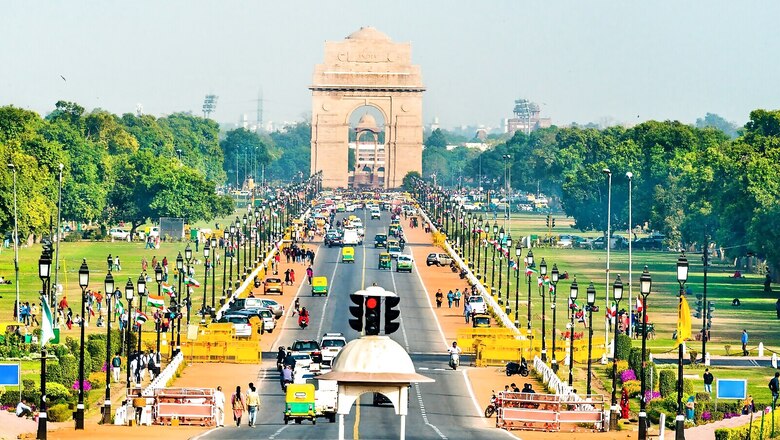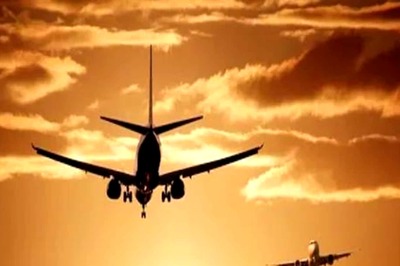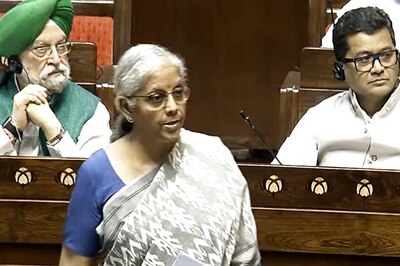
views
In Infra Vaani, noted urban infra expert Akhileshwar Sahay dissects infrastructural challenges of Indian cities and offers solutions. This week, he looks at Delhi, India’s capital.
The infrastructure woes of Delhi – the National Capital Territory and National Capital Region – are so horrendous, they have a new name: The Capital Punishment. Every morning, newspapers mock at the crumbling infrastructure. On March 19 in outer Delhi area, Anil Kumar (40) was riding a scooter when he was run over by a rashly driven Delhi Transport Corporation (DTC) bus. The fleeing driver was, however, nabbed by an alert constable.
This accident transported me to another gory incident in another era. In 1974, aged 19, on my first ride on a DTC bus, unable to enter a moving 666 at Safdarjung hospital, I lost balance, fell and landed with the instant prize – profuse bleeding, multiple concussions, and a broken arm. A day before, I had landed in Delhi with high hopes of getting admission to Jawaharlal Nehru University (JNU).
In so many years, rash driving by DTC bus drivers has remained a constant. Delhi buses, then or now, do not stop. Passengers must risk lives and limbs to board or alight them!
Two, on March 22, fourth year in a row, Delhi was ranked the most polluted capital city in the world – in 2021 its PM 2.5 (96.4 μg per-cum) was 14.6 per cent more than 2020.
It was only in 2005 when Delhi after retrofitting the entire bus fleet to CNG was lauded by the World Bank as the poster-boy of global pollution reduction. The new poster-boy in 2022 is Beijing, which was the pollution capital of the world in 2005. With massive push towards non-polluting public transport, Beijing is no longer in the top 200 polluted cities’ list.
Three, On March 23 this year, the outcome budget placed by Delhi government before the Assembly said “29 per cent of city sewage untreated flowed into Yamuna” and just 6 of its 35 STPS met prescribed 10 mg per-litre wastewater standards for biological oxygen demand (BOD) and total dissolved solids (TDS). It further added that of the 438 samples collected for monitoring of STPs up to December, 48 per cent did not meet prescribed standards. Also, of the 206 samples tested from common effluent treatment plants (CETPs), around 63 per cent did not meet the norms. These two are the major reasons for growing pollution in Yamuna.
Four, a fire that started at Bhalswa landfill in North Delhi last week (April 26) has sparked global media outrage – nearby residents gasp for breath, school for ragpickers’ children is closed and fire-fighters fight for life. At the time of writing this article, the fire had yet to be doused completely. Meanwhile, the political slugfest started in no time. In all of this, everyone is missing the big picture: frequently flaring toxic landfills like Ghazipur, Bhalswa and Okhla are live chemical bombs, threatening to consume Delhi itself.
Five, in April this year, the average Delhi temperature was highest in 72 years sending city’s peak power demand to a record level. CM Kejriwal fears disruption of power supply to hospitals and Delhi Metro. Neighbouring NCR cities are facing severe power outages too. Apart from Dadri II, Delhi’s power comes from far-off plants like Kahalgaon in Bihar and Farakka in Bengal.
Six, on April 28, Delhi unveiled summer mega-plan to supply 1000 MGD (million gallons daily) drinking water, against earlier 935 MGD. Delhi Jal Board plans to deploy 1,198 tankers. This plan will fail if neighbouring states, facing extreme summer like last year, reduce water supply to Delhi. This will put strain on already overexploited, depleted and polluted Delhi groundwater.
These situations are morale crushers. But, these are just the Delhi story, the situation is worse in NCR.
ALSO READ | Infra Vaani | Once Urbs Prima in Indis, Mumbai is Now a City with Maximum Infra Problems
THE TICKING BOMB
First, as per the UN World Population Prospects, in 2028, Delhi (urban agglomeration) with 37.2 million-strong population will be the most populous city on Planet Earth. In 2030, its 39 million population will be far ahead of 37 million in graying Tokyo.
Besides a fast-growing NCT, Noida, Ghaziabad, Greater Noida, Meerut, Gurugram, Bahadurpur, Kundli—Sonipat, Faridabad and Alwar make Delhi the most complex and disjointed urban space globally. The National Capital Region Planning Board (1985) set up by an act of Parliament to catalyse integrated NCR development has failed – in 2020 CAG pulled it up for not preventing haphazard growth in NCR.
Urgent amends are needed to make NCR infrastructure future-ready, lest it gets crushed by a fast-ticking population bomb.
CAPITAL SHOCK
Lucky residents have piped water. But their luck is elusive; on most days, they receive 2-4 hours intermittent, low-pressure, poor-quality water. Getting 24X7 water is a distant dream. The poor without piped water must survive on irregular, insufficient and polluted tanker water. Seventeen per cent Delhi homes have no access to piped water and unauthorised colonies dare not dream of this luxury.
Water wars and water deaths are not unknown. For water, Delhi survives on alms from neighbours: Haryana, Rajasthan, Uttar Pradesh, Uttarakhand and Himachal supply 90 per cent of its needs. Delhi’s woes worsen as DJB squanders 40 per cent water in distribution loss; in contrast, Jamshedpur loses 4 per cent. Further, DJB supplies impure water, to purify it residents use Reverse Osmosis (RO) which results in further loss of 40-60 per cent water.
Delhi government had put the daily demand of water in 2021 at 1380 MGD, its current capacity of 937 MGD is a deficit of 34 per cent. This is the vacuum where water mafia steps in. Can groundwater meet the deficit? I am afraid not.
With decades of unregulated over-extraction, depleted and polluted groundwater is not an option. The findings of the report ‘Tracking hidden crisis in India’s capital from space: implications of unsustainable groundwater use (2022)’ in peer-reviewed journal Nature are scary.
How bad is the NCR story? The answer is far worse.
Alarmed at the worsening water supply, vanishing groundwater and unsustainable construction works in Noida, Greater Noida, Ghaziabad, the Confederation of NCR Residents Welfare Association (CONRWA) in April wrote to Union Jal Shakti Minister and the Prime Minister seeking immediate intervention.
MOUNT QUTUB-WAH TAJ
As per a 2019 estimate, three Delhi landfills – at Ghazipur, Bhalswa and Okhla – sit atop 280 lakh tonnes of solid waste. The 70-acre Ghazipur, the biggest landfill, in 2019 was a 65-metre-high mound, its height may soon dwarf Taj Mahal (73 meter) and Qutub Minar (72.5 meter) if the flattening is not accelerated.
Here in fits the collusive political economy of Delhi’s very own ‘Wah Taj’. Make no mistake, Delhi daily generates 11,400 tonnes of solid waste; of this, 6,200 enters the landfill. Solid waste management rules (2016) mandate at-source waste segregation so that only un-recyclable waste to goes to landfills.
Rules disincentivise door-to-door collection concessionaire; they get more tipping on mixed garbage. No surprise then, daily thousands of trucks transport unsegregated waste – home garbage, medical waste, sewage dumps, plastics, and other combustible substances – to landfills.
This has two-fold results. One, Ghazipur will soon be Delhi’s ‘Wah Taj’ and two, landfills will burn infrequently, every inferno turning worse than the previous one. The political rent-seeking of transporting solid waste to landfills precludes other options – like alternative and decentralised waste treatment, reduction, recycle and use, including vermiculture, fossilisation and composting.
DILLI TERI YAMUNA MAILI
Yamuna had a glorious past; its water was potable, its panoramic view was majestic, evening boat rides were picturesque, and it provided for the fishermen.
It was a different era. Over decades, Yamuna became dirty due to onslaught of untreated human sewage, industrial effluents and trash from unauthorised colonies.
In 2009, while presenting ‘New Industrial Policy for Delhi’ to then chief minister Sheila Dikshit, I wrote the preamble: “There will be no industry in Delhi – either there will be Delhi or industry in Delhi. Only industry which Delhi will have in future is knowledge industry”.
The policy was approved, but industries continued to exist in Delhi. It is quite possible the entrenched industry lobby might have killed the policy at a nascent stage. Had the new industrial policy been implemented, Yamuna would have been somewhat cleaner. But it did not happen.
And, despite thousands of crores of rupees spent since 1973, when Yamuna Action Plan-I was launched, Yamuna is no more a river, it is a dirty frothy nalla.
Deadlines to clean Yamuna have come and gone. Latest is a six-point mantra by chief minister Kejriwal to make Yamuna clean by 2025. He believes that Yamuna polluted over 70 years cannot be cleaned in two days but come 2025 election and one can drink Yamuna water directly from the source.
And why not, London has made Thames water potable and Dutch have made Amsterdam canal water potable. Best of luck Mr Kejriwal.
DELHI: AUTOMOBILE CAPITAL OF INDIA
As per government data, Delhi vehicular population in 2021 was 122.53 lakh; of these four-wheelers account for 28 per cent and two-wheelers 67 per cent. In 2000, the total number of vehicles was 31.64 lakh.
Also, vehicles per thousand population is 655, up from 436, 252 and 192 in 2011, 2001 and 1991, respectively. More vehicles from NCR crowd Delhi roads daily. A Centre for Science and Environment (CSE) study says vehicles accounted for over 50 per cent particulate pollution in early 2021 winter (October 24-November 23). Other studies say 80 per cent of total carbon monoxide and nitrogen oxide emissions are due to vehicular pollution.
DEATH TRAP
In mid-1990s Prime Minister Atal Bihari Vajpayee quipped – “Our roads don’t have a few potholes — our potholes have a few roads.” It is true for Delhi, which forced the Delhi CM take a vow this February to eliminate potholes from Delhi roads in a month. Potholes and damaged roads coupled with rash riving by DTC/cluster buses kill more than a thousand people every year.
In 2019, 1,463 fatal road accidents caused 1,433 fatalities. In 2020, 1,197 deaths were caused by 1,163 road accidents; this is lower than the 2019 figure possibly because of prolonged lockdown, closure of establishments and work and study from home. Eighty-nine per cent of those killed in Delhi road accidents belong to vulnerable groups against national average of 57 per cent.
IN CONTEMPT OF YOUR LORDSHIPS
“We administer, a strong caution to all concerned, that the failure to abide by any of the directions here in above, would invite action under the Contempt of the Courts Act against the defaulters”.
These forgotten words are the concluding paragraph of a historical three-page judgment of Supreme Court division bench of Justice A.S. Anand, B.N. Kripal and V.N. Khare in M.C. Mehta vs GoI & others, on July 28, 1998. The judgment should have transformed capital’s urban transport. It should also have given a body blow to Delhi pollution. Both did not happen. The apex court in 1998 judgment gave 17 directives, but two were considered game-changers: one, augmenting public transport buses (state carriers) to 10,000 and two, converting bus fleet (government and private) to single fuel mode CNG.
The ‘fuel unification to CNG’ judgment lost sheen outside Delhi after GOI in 2003 accepting R.A. Mashelkar’s ‘auto fuel policy’ report asked for setting emission standards, leaving choice of technology and fuel to individuals.
Cut to 2022, with Prime Minister Narendra Modi’s voluntary Glasgow pledge of net-zero emissions by 2070, the game-changer policy now means total war on fossil-fuel, CNG included. This explains country’s focus on metro rail, electric and hydrogen buses.
While flagging the first electric bus in January, Delhi CM called it a “major step towards pollution control”. Ironically, Kejriwal had promised Delhi 1,000 electric buses by 2019, and when the first one arrived in Delhi, Pune was already running 300 electric buses.
To set the record straight, in 2018, the Chinese city Shenzhen had converted entire 20,000 city bus-fleet to electric. After trailblazing progress with electric buses, Chinese cities are now fast moving to hydrogen powered buses, while Delhi wears the crown of the most polluted capital city.
Worse, Delhi has disobeyed the Supreme Court’s 1998 directive to augment Delhi government public transport to 10,000 buses. The DTC fleet of 3,131 buses in 1998 dwindled to 2,000 in 2001. There was a brief blip in 2010 when Delhi had 6,400 buses, but it was a short term effect of Commonwealth Games. DTC last purchased buses in 2008; its fleet has since nosedived to 3,760, with mere 2,894 road-worthy buses. Today 99 per cent of DTC fleet is overaged, waiting to get scrapped. Its losses from Rs 1,215 crore in FY 2016 have soared to Rs 2,000 crore in FY 2019.
Delhi’s killer blueline buses were totally phased out by 2012. Then arrived private cluster buses. Loss of DTC buses is good news for private buses. Their colour changed from blue to orange; their number stood at 3,191 in 2021. Since 2010, Delhi has acquired buses only under the cluster scheme. Compensated on km run daily – they carry no revenue risk – data from 2013-14 to 2020-21 shows high daily kilometre run but low load-factor and passenger ferried.
Delhi FY2022 budget says: ‘Rs 1,500 crore allocated as compensation for meeting deficit of cluster buses.’ If it is not a typo, one tends to suspect – like PPP schemes in other sectors, rent-seeking might be the glue for cluster-bus model too.
Also, killer bluelines have returned as killer orange buses – in the first half of 2021, they had killed 25 people against 12 by DTC buses.
PARKING PROBLEMS
In 2019, a bench of Justice Arun Mishra and Justice Deepak Gupta of Supreme Court observed that parking was amongst the most serious problems in Delhi leading to vehicles being parked on roads and footpaths. The number of vehicles has exploded ever since. The Delhi Maintenance and Management of Parking Places Rules 2019 is not worth the paper it is written and the apex court directive to the Delhi government that while granting permission to build any structure there must be proper assessment of parking needs for the next 25 years is violated with impunity.
Pedestrians, cyclists and even vehicle owners are suffering immeasurably. The parking woes are the symptom of the disease: insufficient public transport in Delhi and NCR. With Delhi and the Union government developing cold feet on further massive expansion of Delhi Metro, DTC on the death bed, and cluster buses fast becoming killer blueline buses of yesteryear, only God can save Delhi.
ALSO READ | Infra Vaani | Infra Woes are Chipping Away at India’s Silicon Valley, Bengaluru is Battling for Survival
THE UNFINISHED AGENDA
This brings to the last point – ‘nation’s pride, the Delhi Metro’.
How does one describe Delhi Metro Rail Corporation (DMRC), the harbinger of change which ushered in nationwide metro rail revolution? In two decades, it has operationalised 450-km metro-rail in NCT, NCR, Kochi and Jaipur and is constructing Delhi Metro Phase-IV and metro projects in Mumbai and Patna.
Let me briefly describe the ‘The Delhi Metro Way’.
Creating and nurturing India’s ‘Next Practices’ (borrowing it from Late C.K. Prahalad), a unique ethical compact, engineer-consultant-contractor partnership and virtuous collaboration, next generation contracting, construction and operational practices, empowering executives with accountability, nurturing home-grown leaders are only few of the aspects of the ‘Delhi Metro Way’.
It is no surprise that Mangu Singh and Vikas Kumar, successors of Metro Man E. Sreedharan, are homegrown leaders who honed leadership skills at DMRC. Delhi Metro is also the mother amoeba that has supplied leadership team to metro rail organisations.
Legendary is the DMRC practice to pay 80 per cent of contractor’s bills in 10 days; this trust creation overnight changed adversarial contractor-client relationship to symbiotic partnership. This practice through Union Budget of FY 2023 has been mainstreamed nationally. This system was crafted by yours truly in 1991, for implementation in the Konkan Railway under supervision of Sreedharan.
But make no mistake, Delhi Metro is a work in progress, and an unfinished agenda. Its network cannot take the load of the most populous city in the world. It has to achieve the construction length of Shanghai first (1000 km) and then cross Beijing which will have more than 1500-km-long route in 2025.
It must emulate Madrid and bring 100 per cent NCR population within one km of a metro station. It must be freed from debt service for completed and future projects. It is time to follow the Singapore model where the government funds construction and the operator is responsible for best practices services.
Lastly, DMRC must be free from the compulsion of making even operational profit. Single-line responsibility of Delhi Metro must be to provide global best services at most affordable cost, operational subsidy should be offered by the government. Even the poorest pays GST, there need not be multiple layers of taxation.
FROM HERE, WHERE?
In 2031, Delhi urban agglomeration will be home to 40 million; by 2050, the population may cross 50 million. There is no global template. Delhi needs its own ‘Next Practices’. And, the time is now.
For Delhi to avoid apocalyptic future and solve its multi-dimensional problems, the immediate requirement is a seamlessly integrated unified governance structure. It needs political sacrifices. Like Lord Shiva, political bigwigs need to drink the poison first – of ceding territory voluntarily – to protect the future of Delhi.
Akhileshwar Sahay is a noted urban transport infrastructure expert and President, advisory services at BARSYL, a consulting firm. The views expressed in this article are those of the author and do not represent the stand of this publication or the company he works with.
Read all the Latest Opinions here




















Comments
0 comment